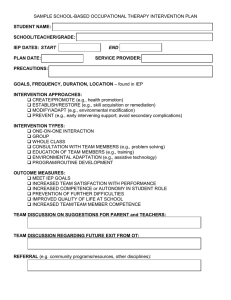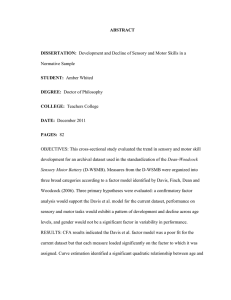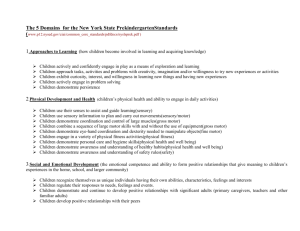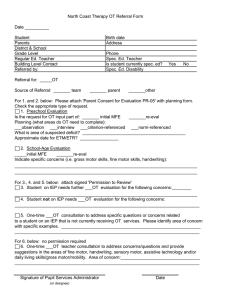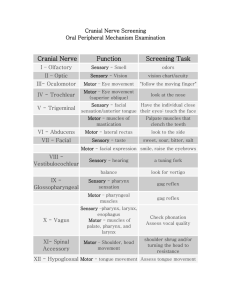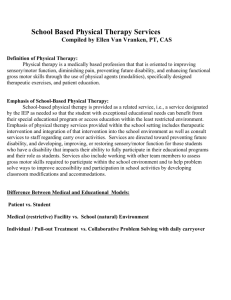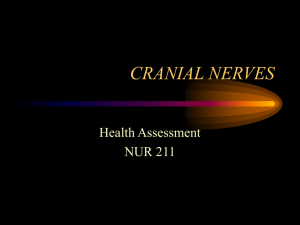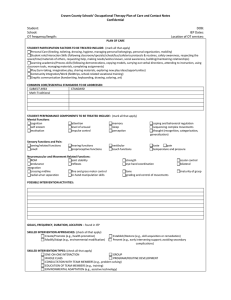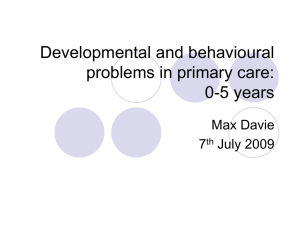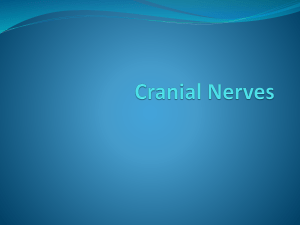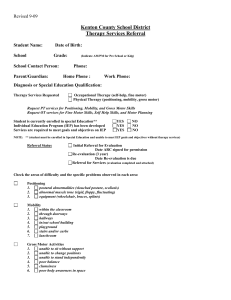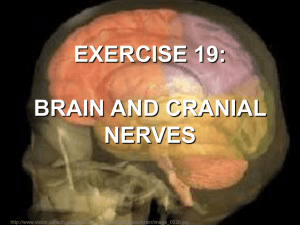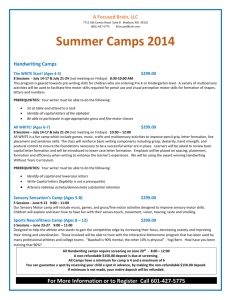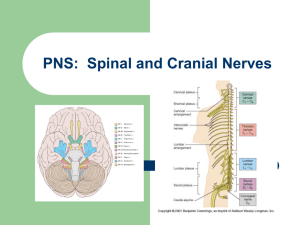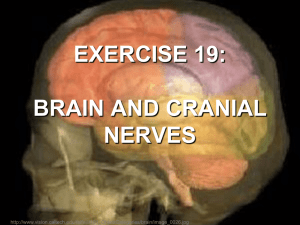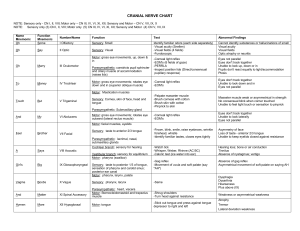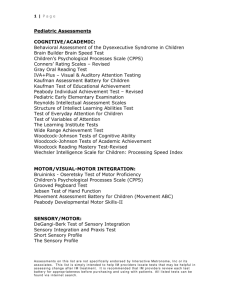OCCUPATIONAL THERAPY PLAN OF TREATMENT
advertisement
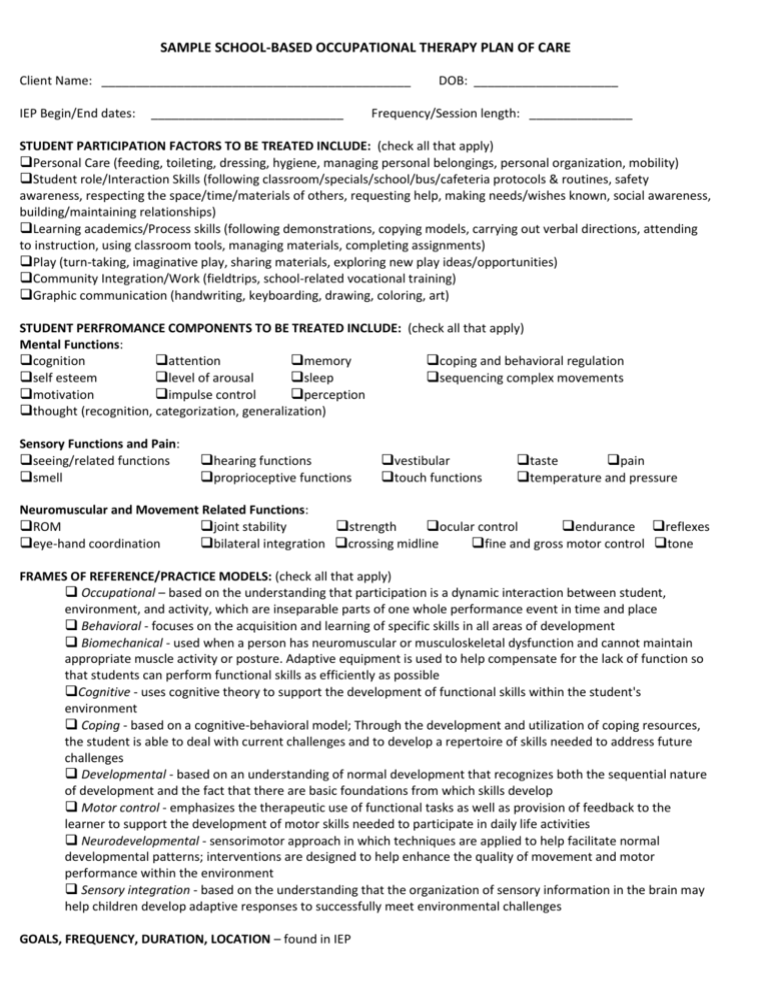
SAMPLE SCHOOL-BASED OCCUPATIONAL THERAPY PLAN OF CARE Client Name: _____________________________________________ IEP Begin/End dates: ____________________________ DOB: _____________________ Frequency/Session length: _______________ STUDENT PARTICIPATION FACTORS TO BE TREATED INCLUDE: (check all that apply) Personal Care (feeding, toileting, dressing, hygiene, managing personal belongings, personal organization, mobility) Student role/Interaction Skills (following classroom/specials/school/bus/cafeteria protocols & routines, safety awareness, respecting the space/time/materials of others, requesting help, making needs/wishes known, social awareness, building/maintaining relationships) Learning academics/Process skills (following demonstrations, copying models, carrying out verbal directions, attending to instruction, using classroom tools, managing materials, completing assignments) Play (turn-taking, imaginative play, sharing materials, exploring new play ideas/opportunities) Community Integration/Work (fieldtrips, school-related vocational training) Graphic communication (handwriting, keyboarding, drawing, coloring, art) STUDENT PERFROMANCE COMPONENTS TO BE TREATED INCLUDE: (check all that apply) Mental Functions: cognition attention memory coping and behavioral regulation self esteem level of arousal sleep sequencing complex movements motivation impulse control perception thought (recognition, categorization, generalization) Sensory Functions and Pain: seeing/related functions smell hearing functions proprioceptive functions vestibular touch functions taste pain temperature and pressure Neuromuscular and Movement Related Functions: ROM joint stability strength ocular control endurance reflexes eye-hand coordination bilateral integration crossing midline fine and gross motor control tone FRAMES OF REFERENCE/PRACTICE MODELS: (check all that apply) Occupational – based on the understanding that participation is a dynamic interaction between student, environment, and activity, which are inseparable parts of one whole performance event in time and place Behavioral - focuses on the acquisition and learning of specific skills in all areas of development Biomechanical - used when a person has neuromuscular or musculoskeletal dysfunction and cannot maintain appropriate muscle activity or posture. Adaptive equipment is used to help compensate for the lack of function so that students can perform functional skills as efficiently as possible Cognitive - uses cognitive theory to support the development of functional skills within the student's environment Coping - based on a cognitive-behavioral model; Through the development and utilization of coping resources, the student is able to deal with current challenges and to develop a repertoire of skills needed to address future challenges Developmental - based on an understanding of normal development that recognizes both the sequential nature of development and the fact that there are basic foundations from which skills develop Motor control - emphasizes the therapeutic use of functional tasks as well as provision of feedback to the learner to support the development of motor skills needed to participate in daily life activities Neurodevelopmental - sensorimotor approach in which techniques are applied to help facilitate normal developmental patterns; interventions are designed to help enhance the quality of movement and motor performance within the environment Sensory integration - based on the understanding that the organization of sensory information in the brain may help children develop adaptive responses to successfully meet environmental challenges GOALS, FREQUENCY, DURATION, LOCATION – found in IEP SKILLED INTERVENTION APPROACHES: (check all that apply) Create/Promote (e.g., health promotion) Establish/Restore (e.g., skill acquisition or remediation) Modify/Adapt (e.g., environmental modification) Prevent (e.g., early intervening support; avoiding secondary complications) Occupation-based interventions (training embedded in actual activity e.g., personal care, using classroom tools) Purposeful activities (individual activities/components of activity that develop skills) Preparatory methods: Therapeutic exercise Treatment of oral function/oral motor techniques Sensory activities Splinting/orthotics Visual perceptual training Assistive technology/Adaptive equipment training SKILLED INTERVENTION TYPES: (check all that apply) ONE-ON-ONE INTERACTION GROUP WHOLE CLASS PROGRAM/ROUTINE DEVELOPMENT CONSULTATION WITH TEAM MEMBERS (e.g., problem solving) EDUCATION OF TEAM MEMBERS (e.g., training) ENVIRONMENTAL ADAPTATION (e.g., assistive technology) DISCHARGE PLAN: The IEP team will consider data for the student to be exited or Plan of Care will be modified in accordance with student’s needs based on one or more of the following events: 1) Goals are achieved 2) OT is no longer required for the student to benefit from special education program at this time 3) Parent request TEAM DISCUSSION ON SUGGESTIONS FOR PARENT and TEACHERS: COMMUNITY SUPPORTS & COLLABORATION (e.g. community programs/resources, other disciplines): This plan was created by: _________________________________ (Therapist Signature and Credentials) on: __________________ (date)
